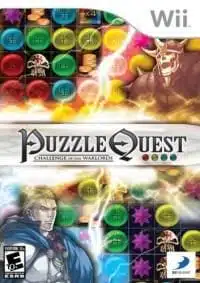
Note: Puzzle Quest: Challenge of the Warlords‘ Wii version was reviewed by Jason Cook last year. With the sequel (Puzzle Quest: Galactrix) imminent, I wanted to explore just what made the original so arresting.
The valiant knight and the ferocious minotaur speed toward each other, running full-bore toward what will surely be a fierce, violent battle for the ages. The knight’s sword is drawn, the minotaur’s horns bared and brandished, and those who may have been battling around them are now unable to avert their gaze from the spot at which the two warriors are destined to meet. Some seek cover, others exhort the heavens, but all recognize the epic scope of the clash about to take place…
…and as they approach each other, a table falls out of the sky, the two combatants pull previously unseen chairs out from some undefined space behind them for the sake of sitting at the now-landed table, and a board game ensues with the understanding that the winner gets to slit the loser’s throat.
While it may sound ridiculous, this is exactly the sort of imagery that comes to mind when one starts playing Puzzle Quest: Challenge of the Warlords for too long on too many late nights.
This is also the sort of imagery that brings to mind Clint Hocking’s “ludonarrative dissonance“; that is, the artistic phenomenon unique to gaming that places the gameplay at odds with the story. We’re taking part in a large-scale narrative that deals with warring lands, Homeric journeys and arduous quests, and yet, whenever we’re asked to do something important, we do so by playing a game of Bejeweled. One really has nothing to do with the other, except that winning means winning, so whenever there is a situation that calls for an explicit win/loss state, a ferocious casual game breaks out.
What’s interesting about this particular example of gameplay’s conflict with the narrative is that it seems to have enhanced, rather than degraded, the player’s experience. Puzzle Quest was all but universally acclaimed when it was released back in ’07, at a time when a rather large portion of the gaming populace had already given up on the type of game from which the majority of Puzzle Quest‘s structure is derived: the JRPG. You walk around the world, occasionally getting into pseudo-random battles, doing quests and side quests for the various people you meet along the way, increasing in power as you gain levels through battle and good deeds. It’s a JRPG through and through, infused with constant Bejeweled-style battles instead of constant turn-based attack/defend/magic-style battles.
Why then, despite this apparent disconnect in genres, is Puzzle Quest such a success? It was even in the game-of-the-year discussion for a couple of platforms in ’07 (hello, PSP!).
Part of the reason may be that the story being at odds with the gameplay is an issue inherent in the battles of the turn-based RPG genre anyway. Instead of playing out confrontations, say, Devil May Cry or God of War-style, we’re asked to imagine the majority of the action as we slowly and deliberately decide whether our avatar(s) will attack, run, or perform one of a select group of spells. The story says the stakes are high and the action intense, while the gameplay is almost passive in its non-urgency. As such, replacing one dissonant set of actions with another actually feels like innovation, every battle its own little game-within-a-game rather than a set of almost inconsequential button presses followed by a usually predetermined outcome.
Another reason for the success? Quite frankly, adding Bejeweled to anything makes it feel more accessible. At this point, Bejeweled is an almost universal symbol of casual gaming, something that even those who run screaming from people who identify themselves as “gamers” have at least had some experience with. By introducing a Bejeweled-style battle mechanic, players who typically identify exclusively with the casual side of the game spectrum are introduced to an adventure style that they may never have had the inclination to previously attempt.
What developer Vicious Cycle seems to have done, then, is embraced the dissonance, deciding that if play befitting the narrative is not a priority for the genre anyway, why not make it more interesting? By embracing, and even highlighting the story/gameplay disconnect, they’ve created something that somehow manages to feel innovative despite the utter lack of innovation that each portion of the gameplay presents on its own.
Perhaps this explains the game’s fascinatingly addicting quality, something that’s inexplicably ensnared this writer (in the face of things I should be playing) for the last two weeks straight. Either that, or there are just a whole lot of Bejeweled lovers in some serious denial.
